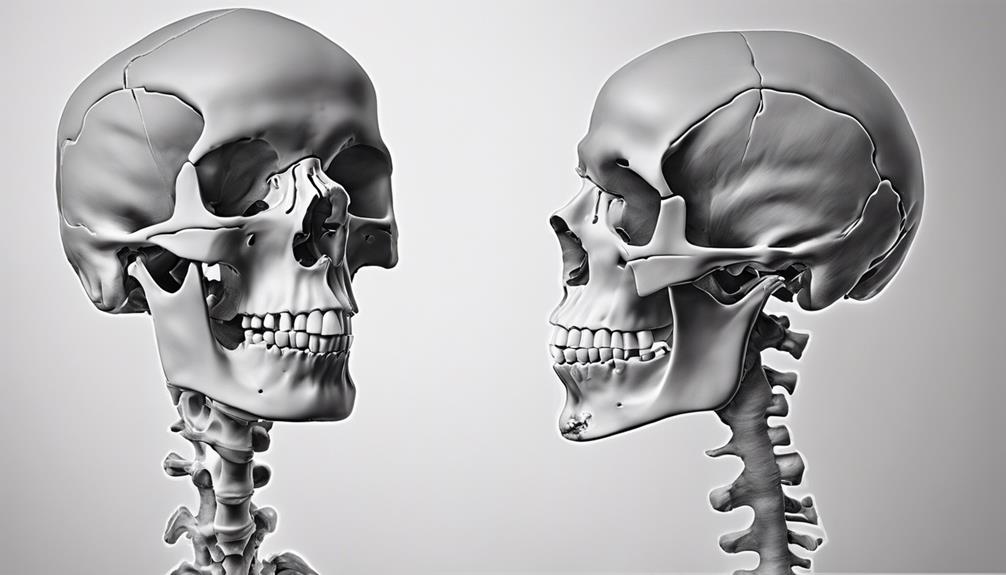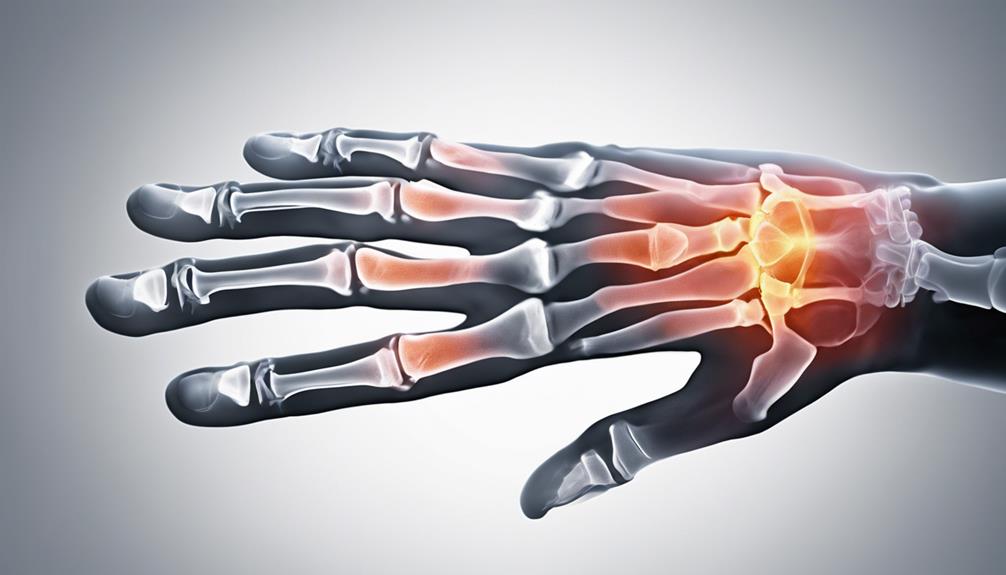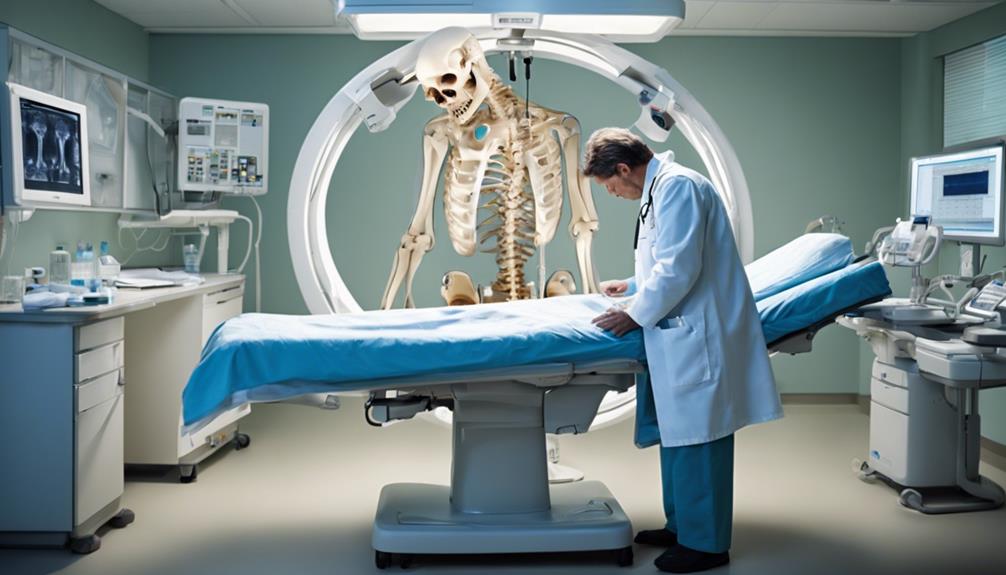When looking at an X-ray of arthritis, it’s like interpreting a silent tale told through shadows and forms. The detailed patterns visible in these images provide understanding of the realm of joint degeneration and swelling.
As we observe the subtle changes within the bones and surrounding structures, a deeper understanding unfolds, shedding light on the progression of this common condition. But what exactly does arthritis look like on an X-ray, and how can these visual clues impact diagnosis and treatment decisions?
Let's explore the visual manifestations of arthritis through the lens of X-ray imaging to uncover the secrets hidden within these captivating images.
Key Takeaways
- Joint space narrowing is a common indicator of arthritis on X-ray.
- Bone spurs or osteophytes are visible signs of arthritis in X-ray images.
- Cyst formation can be observed in joints affected by arthritis.
- Subchondral sclerosis is a characteristic feature seen in arthritic joints on X-ray.
Characteristics of Arthritis on X-ray
When analyzing arthritis on an X-ray, the characteristic findings include joint space narrowing, subchondral sclerosis, osteophyte formation, and cyst development.
Osteoarthritis, the most common type of arthritis, manifests on X-rays by showing a reduction in the space between the joints due to cartilage wear and tear. This narrowing is a key indicator of degeneration in the affected joints.
Subchondral sclerosis, seen as denser bone beneath the cartilage, indicates the body's attempt to reinforce the weakened joint structure.
Osteophytes, also known as bone spurs, are bony outgrowths that form around arthritic joints, serving as stabilizers but potentially causing pain and limited mobility.
Additionally, cysts may develop near arthritic joints as a response to the increased pressure and inflammation in the area. These characteristic findings on X-rays provide valuable insights into the extent and nature of arthritis affecting the bones and joints, aiding in accurate diagnosis and treatment planning.
X-ray Findings in Arthritic Joints

In assessing arthritic joints on X-rays, the narrowed space between bones serves as a prominent indicator of cartilage loss. This narrowing is a hallmark of osteoarthritis, reflecting the wear-and-tear processes affecting the joint.
Additionally, the X-ray images may reveal the presence of bone spurs or osteophytes along the edges of the affected joints. These bony changes can contribute to joint deformity, leading to a crooked appearance in severe cases of arthritis.
Furthermore, small bone cysts within the joint may be visible on X-rays, indicating the progression of the disease. Comparing these findings to a normal X-ray can help healthcare providers pinpoint specific changes characteristic of arthritis, aiding in diagnosis and treatment planning.
Thorough evaluation of these X-ray features is crucial in identifying and monitoring conditions like thumb arthritis, guiding effective management strategies for patients.
Identifying Arthritis Through X-ray Imaging
Upon examination of X-ray images, the identification of arthritis is characterized by joint space narrowing, bone spurs, osteophytes, cyst formation, and visible joint deformities. These features help healthcare professionals diagnose arthritis and plan appropriate treatment. The table below summarizes the key markers of arthritis visible on X-ray imaging:
| Arthritis Feature | Description |
|---|---|
| Joint Space Narrowing | Indicates cartilage loss and degeneration in the joint |
| Bone Spurs/Osteophytes | Bony outgrowths at joint edges contributing to symptoms |
| Cyst Formation | Fluid-filled sacs within the bone indicative of arthritis |
| Joint Deformities | Abnormal joint shapes leading to a crooked appearance |
Visual Signs of Arthritis on X-ray

Moving from the identification of arthritis features on X-ray imaging, our focus now shifts to visually discerning the subtle signs of arthritis through detailed radiographic analysis. When examining X-ray images for signs of arthritis, several key visual indicators can help in the diagnosis.
- Joint space narrowing: A common feature indicating cartilage loss in arthritic joints.
- Bone spurs or osteophytes: Visible bony projections that develop around arthritic joints.
- Crooked finger appearance: An angular deformity often seen in patients with arthritis.
- Subchondral cysts: Fluid-filled sacs that can be observed around affected joints on X-rays.
- Joint sclerosis: Increased bone density, suggestive of arthritis, evident on X-ray imaging.
Arthritis Manifestations in X-ray Images
Analyzing arthritis manifestations in X-ray images reveals distinct visual cues that aid in the precise identification and assessment of the disease's progression. In these images, joint space narrowing is a common finding, indicating cartilage loss, a hallmark feature of arthritis.
Additionally, the presence of bone spurs or osteophytes along the edges of the joints is often observed, contributing to the characteristic appearance of arthritis on X-ray. Subchondral sclerosis, characterized by increased bone density, is another key feature visible on X-ray images of arthritic joints.
Furthermore, the formation of cysts around affected joints can be visualized, providing further insight into the extent of the disease. In advanced cases, arthritis can lead to joint deformities and alterations in normal bone alignment, which are evident in X-ray images.
Frequently Asked Questions
How Can Doctors Tell if You Have Arthritis?
Doctors can diagnose arthritis through physical examinations, medical history assessment, and imaging tests like X-rays. Signs such as joint pain, stiffness, swelling, and limited range of motion are key indicators. Blood tests can also help identify specific types of arthritis.
Once clinical symptoms are considered, imaging techniques like X-rays can confirm the presence of arthritis by revealing characteristic changes in the affected joints' bone structure and alignment.
What Does the Beginning of Arthritis Look Like?
At the beginning stages, arthritis may present with subtle joint space narrowing and minimal osteophyte formation. Initial signs could include mild subchondral sclerosis and small cysts or bony erosions near the joint. Deformities or significant cartilage loss may not be prominent on X-ray imaging initially.
These early findings indicate mild bone changes and serve as crucial indicators for diagnosing arthritis. Early detection allows for timely intervention and management of the condition.
Conclusion
In conclusion, when examining X-ray images for signs of arthritis, it's important to look for characteristic features such as:
- Joint space narrowing
- Bone spurs
- Cysts
- Joint deformities
These findings can help diagnose arthritis early on and guide treatment decisions.
But have we truly explored all the nuances and intricacies of arthritis manifestations in X-ray images?









